Yogesh Bajpai
Department of Library and Information Science, College of Natural and Computational Sciences, Mekelle University, Mekelle, P. O. Box-231, Ethiopia
Correspondence to: Yogesh Bajpai, Department of Library and Information Science, College of Natural and Computational Sciences, Mekelle University, Mekelle, P. O. Box-231, Ethiopia.
| Email: |  |
Copyright © 2012 Scientific & Academic Publishing. All Rights Reserved.
Abstract
Community reading rooms (CRRs) are an extension of Eritrea’s Public Library Service into rural areas for adult literacy programs. At its beginning in 1993, the CRR project was closely linked to the adult literacy programme of the Department of Adult Education of Eritrea. The CRRs were intended primarily to serve adult literacy learners and newly literate adults. However, because the CRRs had to be housed at first in existing school buildings, farmers, schoolchildren have become the most active and most numerous users. The villages have claimed the CRRs as an important part of community life.
Keywords:
Rural Libraries, Community Reading Rooms, Eritrea-Adult Literacy
Cite this paper: Yogesh Bajpai, Community Reading Room (Public Library) as an Instrument in Eradication of Adult Illiteracy: A Case Study of Eritrea (North East Africa), International Journal of Library Science, Vol. 2 No. 2, 2013, pp. 26-42. doi: 10.5923/j.library.20130202.02.
1. Introduction
The Community Reading Rooms project in Eritrea serves as an outreach service for communities far away from the major centres where public libraries are not located. In Eritrea still they have not established Eritrean National Library and National Library Service outreach programmes include the Mobile Libraries and the Book Box Service. Community reading rooms (rural libraries) are important features of the literacy programme especially in the rural areas. They are important sources of information for the learners and as such are expected to cultivate reading habits among the rural people. However, their coverage is limited, as they are only about 83 community reading rooms are serving for rural Eritrean society, 15 Community Reading Rooms were first piloted in 1993.[1]. Also, they currently possess very limited reading materials in science, social science, and language, particularly in mother tongue. Most contain available in Tigrinya, and only a few feature materials in Tigre and Bilen (the Adult Education Department is trying to publish reading material in other 5 Eritrean ethnic languages). The attendants or para-librarian have not received any relevant adequate training. By broadcasting educational topics such as health, environment, social, legal and agricultural issues etc. in 4 local languages for the public and the illiterate population in particular through the educational radio program of the Ministry of Education. All these effort is to cerate literate environment and to sustain learning and promote lifelong learning.The Community Reading Rooms (CRRs) are a rural library network originally aimed at providing basic reading material to neoliterates who have gone through the Department of Adult Literacy (DAL) Programme. The service is similar to that of the public library, but on a very small scale. Each CRR starts with a base stock of 250 titles. There is a reference section, a periodicals section that may only be used on the premises, and the normal circulation service. Users may borrow one book at a time for a period of one week. The CRRs are also serving as social/cultural centres. In most villages, the CRR is the only building with electricity; so many cultural and social activities take place there.
1.1. Scope of the Study
Eritrea is one of the countries that have the highest share of the world’s illiterate population. At this stage, about 70 percent of the country’s adult population is illiterate. Despite Eritrea’s commitment and determination to provide basic education for all, 66.6 percent children are currently out of the school system, these are potential adult illiterates. These high rates, combined with the persisting gender and regional disparities in education, are totally intolerable social situation in a country such as Eritrea where human capacity development is the top priority.
1.2. Objective of the Study
Ⅰ) To introduce and execute theoretical concept of Community Reading Room (rural public library) to enhance adult literacy rates/ programmes.Ⅱ) To design adult literary campaign for the benefit of different segments of Eritrean society, especially with the help of CRRs.Ⅲ) To educate people with emerging audio-visual aids to enhance literacy rate amongst them.Ⅳ) To measure and quantify the impact of adult literacy campaign in Eritrea and suggest prospective strategies to enhance its productivity/efficacy.
2. Material and Methods
The methodology of the study is a survey-based approach to know the views of the public of all Districts of Eritrea. The survey consists of both the focus group interview method and the questionnaire approach. The focused interview may confine the respondent to a discussion of issues with which seeking the conversance, the interviewer has freedom to explore reasons and motives. The questionnaire approach may reveal an authentic record of the given situation. The study is based on sample survey and the sample is to meet not less than 150 persons in each District (Zoba). Total 6 Zoba of the whole population of Eritrea. In each Zoba, the samples have been collected using simple random sampling method. In this sample, it has been planned to cover some rural as well as urban areas of all Zoba. There is no group on the characteristics like sex, age, economic group, occupation, etc. The samples might have certainly represented the views of different kinds of people of the country.In direct method, experts are expected to give answers to questions of various kinds that explicitly pertain to the constructed membership function. In my research study according to demography of Zoba I have selected from Anseba 175, 150 from D.K.Bahri, 160 Debub, 175 from Gash Barka, 310 from Maekel and from S.K. Bahri 150 persons have randomly been selected from all the six Zobas. Since Zoba Maekel, is the most populated areas, some extra samples were added for this area. All together 1120 samples have been collected, which counted as a good sample for the analysis of the project and their opinions were given as data in the selection of attributes. As much as possible the survey has covered both rural and urban areas to get collective opinion of the public. In indirect methods, experts are required to answer simpler questions, and less sensitive to the various biases of subjective judgment, which pertain to the constructed membership function only implicitly. In our research study, one member from each Zoba of Eritrea was taken as the expert and their collective opinion also studied. Questionnaires using to find out Eritreans feelings towards literacy and its benefits in the development of Eritrea. Their responses are compared in terms of Gender, Residence, and literacy level.
3. Litreatue Review
The idea of Community Reading Rooms was first mooted in Africa at the Botswana Library Association’s (BLA) Libraries and Literacy Conference held in Kanye, a southern rural village in Botswana, in 1985. The idea was born out of a perceived need to take library services to the grassroots. The BLA Kanye Conference brought together librarians and literacy personnel to develop a common strategy that could offer the illiterate population the means to become functionally literate[2] . The first literacy project, (1993-1995) focused on the remote rural areas of the country to reach out to the disadvantaged. This project faced many constraints, which stemmed from improper planning and monitoring producers. Basically it lacked on essential feasibility assessment from the outset in identifying the potential learners, availability of convenient learning sites and supervision mechanisms. As a consequence, the number of participants and centres declined drastically. The life span of the projects was three years, but 18 out of the 25 centres phased out earlier. Had an assessment and situational analysis been done, major constraints and attitudes towards the literacy project would have been noted and actions taken accordingly[3] .Explore the major information and services of the rural development libraries in Dhaka, Comila and Bogra district in Bangladesh. Discusses the situation of these rural development libraries due to the revolution and the advancement made in the in the information communication [4]. After independence, India has experienced growing population of literate ad educated citizens due to various efforts in universalisation on elementary education through programmes like, Sarva Shikha Abhyan (SSA), District Primary Education Programme (DPEP), national Literacy Mission and so on. On the other hand, for the facilitation and other agencies have established public libraries. The community information centers and village knowledge centers are the recent addition to this effort that would transformation India into an Information Society[5] .The public library is an essential element in literacy an lifelong learning , as it is the place which provides access to learning. In a developing country like Sri lanka, where individuals cannot afford to provide their own learning material, the public library has a significant role to play in dissemination literacy and lifelong learning[6] .Australia, adult literacy programmes began with a pilot programme at the Council of Adult Education in 1972. By 1982, 10% of the Victoria public library service co-operated in the provision of adult literacy classes and by 1991, this had risen to 25% with another 10% providing support for adult literacy programmes in other ways[7].By using the library with their children, parents are setting a good example and help to establish a motivation for reading and a pattern for lifelong learning. In Slovenia, public libraries were among the first providers of intergenerational lifelong learning processes that included children, youth and adults who came together and learned from each other by exchanging knowledge, experiences and viewpoints[8].The situation of libraries differs enormously worldwide. Some countries and regions, such as the United Kingdom, have well-supported library systems, where awell-established library network extends to every community. In stark contrast are countries such as Kenya with only 36 public libraries, Namibia with 48 and Zambia with 22 public libraries[9] . Nigerians have traditionally been leaders in African Librarianship. Public Libraries in Nigeria, there are 30 PL headquarters in all the 30 states of the Federation and the Capital Territory, Abuja with more than 140 service points all over the Federation, spanning the urban and rural areas. Most of the PLs have been instituted by laws which differ from state to state. Attempts at producing a standard law for PLs has almost been completed by the Conference of Chief Executives of Library Boards in Nigeria and is awaiting ratification by the National Consultative Forum of Chairmen of PLs in Nigeria. When operational, this will serve as a model law which will determine how existing laws are modified and new ones formulated[10] .
4. Analysis and Interpretations
Responses from different Gender, Residence and LiteratesTable 1. Responses from different Gender, Residence and Literates
 |
| |
|
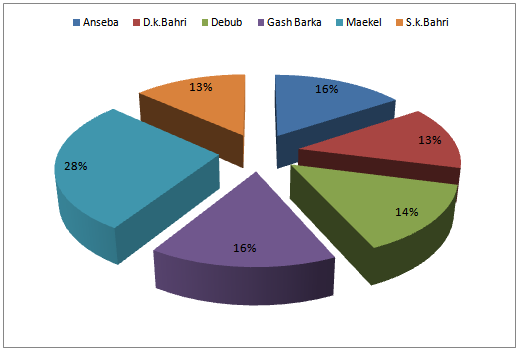 | Figure 1. Responses from different Zobas |
More participants were males (58.48%) comparing to females (41.52%) in the survey. The rural and urban ratio is 57% and 43% respectively. Most of the participants (78.75%) were literate revealing that illiterates are not willing to respond to the study. This indicates the fear and negligence of illiterates.Responses from different Age GroupsThe man’s mind does not stand still at a given age. Earlier it was believed that the human beings lose the power to learn in inverse ratio to their age. The child’s mind is plastic and that of an adult is fixed and incapable of changing. It has been proved that learning power diminishes with growing age but this loss is very gradual. The adults between 25 and 35 years of age learn faster that the children. However peak of learning occurs between 20 and 25. Table 2. The respondents were examined on the basis of their age group
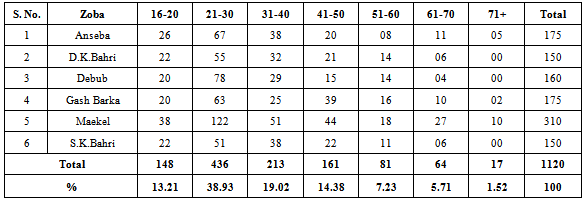 |
| |
|
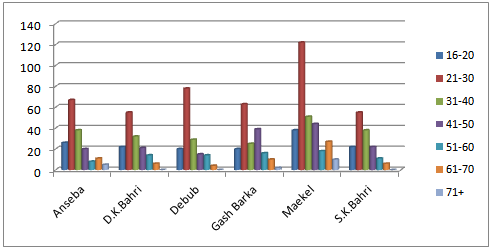 | Figure 2. Respondents examined by age group |
Most of the respondents (38.93%) were between 21-30 years of age revealing that they are generally young; their views were taken seriously as a large proportion of the population of Eritrea is below 24 years.Respondents by ProfessionTo know the effect literacy among the respondents, their views were taken with respect to their professions. Table 3. Respondents by Profession
 |
| |
|
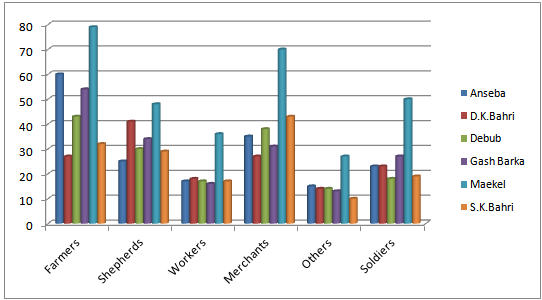 | Figure 3. The Respondents by Profession |
Majority of the respondents were either working as farmers (26.34%), Shepherds (18.48%) or Merchants (21.79%). And their opinion plays a major role in analysis.Respondent Type of Education Literacy has important educational benefits. It used to be thought that literacy contributed to the development of abstract reasoning. In general, ‘the effects of literacy are more likely to be determined by formal schooling, socialization, and the cultural practices of a particular society. Table 4. Educational status of the respondents
 |
| |
|
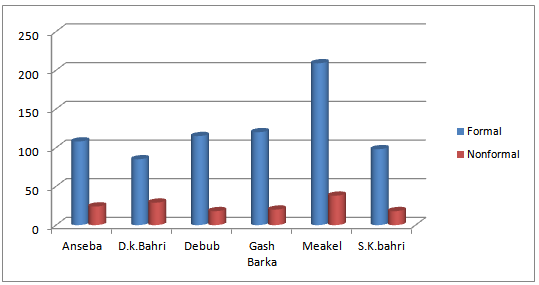 | Figure 4. Educational status of the respondents |
Importance of Education among Illiterate The awareness of education among the illiterates respondents were illustrated in the following table. This helps the Government for future course of action plan in planning a public library system.Table 5. Importance of education among Illiterate
 |
| |
|
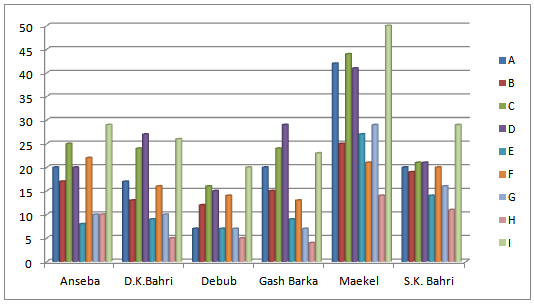 | Figure 5. Importance of Education among Illiterates |
 Opinion of the illiterates has revealed the following pattern. About 64.71 percent people were of the opinion that so as to gain knowledge and wisdom education plays a important role, however 64.59 percent of the respondents amongst illiterates considered that education causes awareness towards society and world. About 74.37 percent respondents felt to go for learning in another area where public library can play a major role.Hobbies of Illiterates
Opinion of the illiterates has revealed the following pattern. About 64.71 percent people were of the opinion that so as to gain knowledge and wisdom education plays a important role, however 64.59 percent of the respondents amongst illiterates considered that education causes awareness towards society and world. About 74.37 percent respondents felt to go for learning in another area where public library can play a major role.Hobbies of IlliteratesTable 6. Hobbies of Illiterates
 |
| |
|
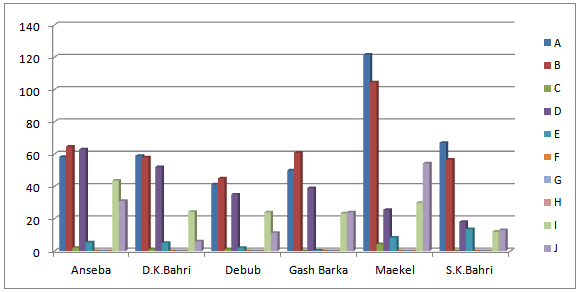 | Figure 6. Hobbies of Illiterates |
 Out of 238 respondents in 24 hours makes 5712 man hours. Out of this 5712 hours time about 397.2 hours were just spent in chatting which makes it very clear that about 6.95 percent of their time was wasted in chatting. Similarly 6.82 percent of their time was spent in viewing television, 4.07 percent was spent for gambling. Hence it is clear that illiterates waste their time in evil affairs rather than construction matters.Utilizing mass media by residenceThe information needs of rural may be better served by radio and television broadcasting, among other means, but in order to assess the possibilities and establish clearly defined roles in information provision for library services on the one hand and broadcasting services on the other, it is necessary to obtain a clear picture of the existing situation in the field of broadcasting in Eritrea .The following table illustrates the utilization of the different media system both in rural and urban sector.
Out of 238 respondents in 24 hours makes 5712 man hours. Out of this 5712 hours time about 397.2 hours were just spent in chatting which makes it very clear that about 6.95 percent of their time was wasted in chatting. Similarly 6.82 percent of their time was spent in viewing television, 4.07 percent was spent for gambling. Hence it is clear that illiterates waste their time in evil affairs rather than construction matters.Utilizing mass media by residenceThe information needs of rural may be better served by radio and television broadcasting, among other means, but in order to assess the possibilities and establish clearly defined roles in information provision for library services on the one hand and broadcasting services on the other, it is necessary to obtain a clear picture of the existing situation in the field of broadcasting in Eritrea .The following table illustrates the utilization of the different media system both in rural and urban sector. Table 7. Utilizing Mass Media by residence
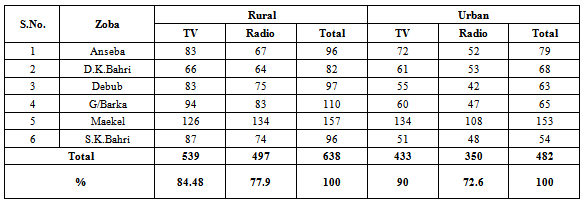 |
| |
|
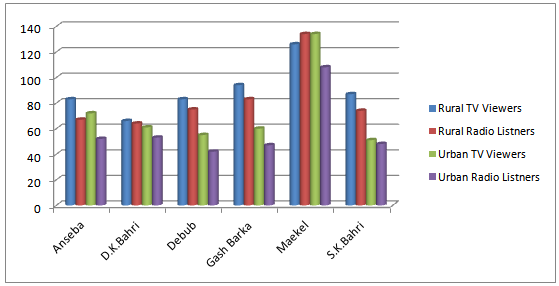 | Figure 7. Utilizing Mass media by residence |
In rural, 84.48% acquires T.V and 77.90% radio and in urban, 89.83% acquires T.V and 72.61% radio. That is more radio in rural and more TV in urban areas. Necessity of public library for village / town (Residence & Gender)The tables 8, 9 and 10 projects the necessity of public library for village / town in terms Residence, Gender, age group and occupational group respectively.Table 8. Necessity of public library for village / town (Residence & Gender)
 |
| |
|
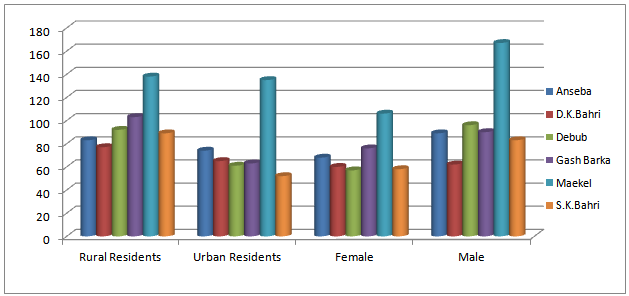 | Figure 8. Necessity of Public Library for Village/ town (Resident and Gender) |
Out of 1120, 1032, i.e., 92.14% of the people responded that they need public library for their own village or town. Necessity of public library for village / town: (by Age Group)This factor urges to establish public libraries in all villages and towns of Eritrea. It is important to note down that more people from rural area (51.96%) want public library for their villages. This shows the non availability of other information sources. Among women only 38% respondents like to have public libraries at their locality. This implies the need of special attention to motivate females to utilize libraries.Table 9. Necessity of public library for village / town: (by Age Group)
 |
| |
|
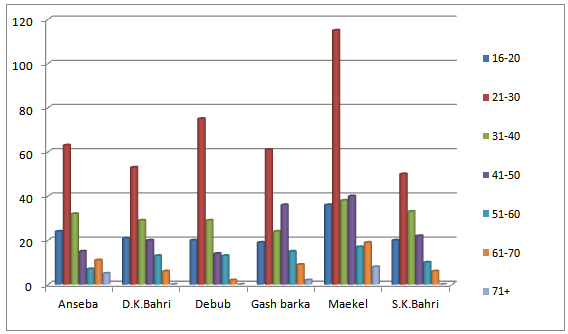 | Figure 9. Necessity of Public Library for Village/town: ( by Age Group) |
Necessity of public library for village / town: (Occupation Group)Table 10. Necessity of public library for village / town: (Occupation Group)
 |
| |
|
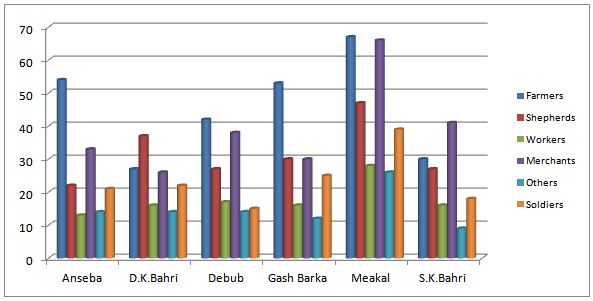 | Figure 10. Necessity of Public Library for Village/town: (Occupational Group) |
Majority of People in the age group of 21-30 require a public library in their locality i.e more than 37%. This idea has been confirmed by the government employees and the students put together is more than 45%. Around 17% people working in private sectors also show more interest to have public libraries in their localities.The Need of Public libraryThe existence of every system require certain objectives from the concerning consumer. The following table projects the need of public library. Table 11. The Need of Public library
 |
| |
|
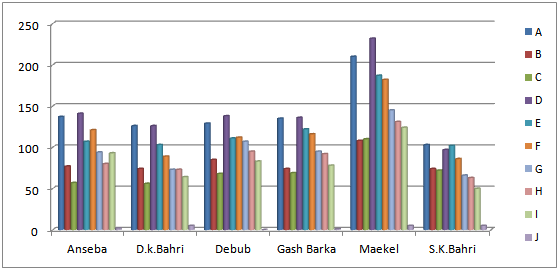 | Figure 11. Need of Public Library |
 75% of respondents feel that they can spend their leisure time usefully if they have a library in their places after completion literacy course. This implies that the public library definitely will create some positive changes in Eritrean life style. And also a majority of people i.e. 77.68% feels they will acquire knowledge or adult education. More than 38.57 % Eritrean want reading materials which is related with their professional skills in libraries.Ranking of Reading materialsRanking Resources for a new establishing public library system.The following tables 12, 13 illustrate the ranking of reading materials and subjects in the proposed new public library.
75% of respondents feel that they can spend their leisure time usefully if they have a library in their places after completion literacy course. This implies that the public library definitely will create some positive changes in Eritrean life style. And also a majority of people i.e. 77.68% feels they will acquire knowledge or adult education. More than 38.57 % Eritrean want reading materials which is related with their professional skills in libraries.Ranking of Reading materialsRanking Resources for a new establishing public library system.The following tables 12, 13 illustrate the ranking of reading materials and subjects in the proposed new public library.Table 12. Ranking of Reading materials
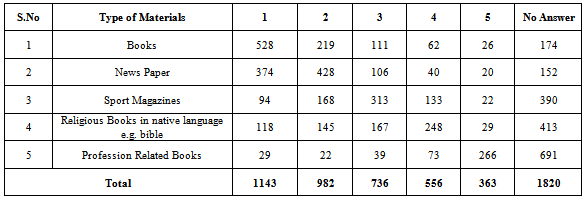 |
| |
|
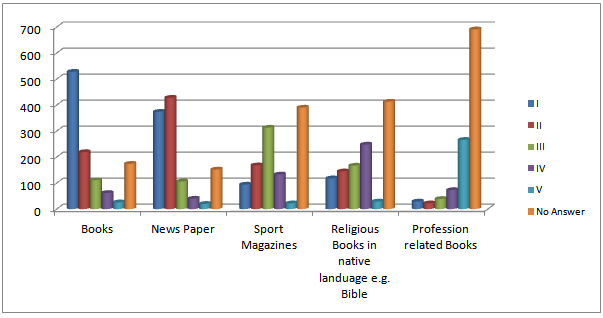 | Figure 12. Ranking of Reading Materials |
Ranking the type of reading materials, most of respondents gave top priority to books and the second priority goes to newspapers and the third one is to periodicals. According to the, it is necessary to note down that the e-books are not so familiar among Eritrean.Ranking of SubjectsTable 13. Ranking of Subjects
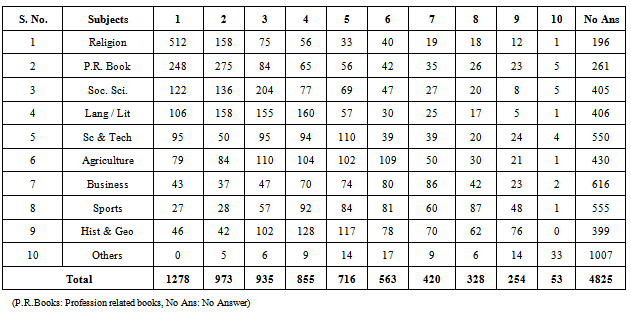 |
| |
|
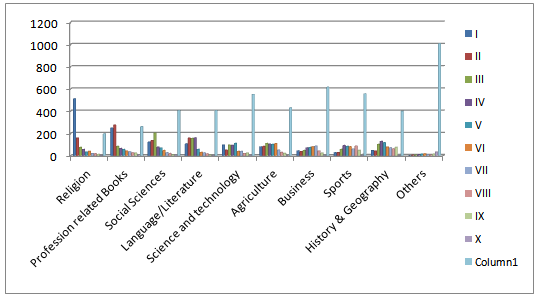 | Figure 13. Ranking of Subjects |
While ranking the subjects, the majority of the people give top priority to general knowledge, followed by religion, social sciences, language and literature. Next the respondents gave more importance to agriculture and history and geography. In this country, people have no much interest in science and technology.Expecting services from the Public LibraryTable 14. Expecting services from the Public Library
 |
| |
|
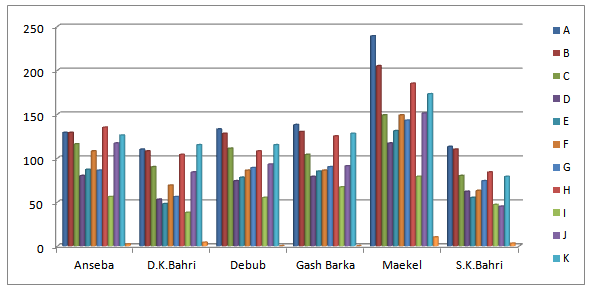 | Figure 14. Expecting services from the Public Library |
 From the existing system to a new system of library, the users were asked the service preferred. The following depicts the opinion of the users in this regard.Most of the respondents prefer circulation of books, periodicals and other reference materials. The essential factor to note down that more than 65% of the respondents have stressed the need of public library services to attract the children, women, old aged people and the library service to educate the illiterates. National development and Right to information about Public LibraryNational developments in terms of happiness of Eritrean people, rather than in terms of an abstract economic measurement of Gross National Product. The principle describes the development as a continuous process towards a balance between material and non-material needs of individuals and society. National Development has become the philosophical foundation for the policy making process and implementation in Eritrea.Freedom of information legislation described as open records or sunshine laws are laws which set rules on access to information or records held by government bodies. In general, such laws define a legal process by which government information is required to be available to the public. In many countries there are constitutional guarantees for the right of access to information, but usually these are unused if specific legislation to support them does not exist. Over 70 countries around the world have implemented some form of such legislation. In India, the Right to Information Act (RTI Act) was introduced to the Indian Parliament in July 2000. It came into effect on 12 Oct 2005. Other countries are working towards introducing such laws. http://rti.gov.in[11]The tables 15 and 16 depict the opinion of respondents of the survey on the GDP and the right to information respectively.Public Libraries towards National Development of Eritrea
From the existing system to a new system of library, the users were asked the service preferred. The following depicts the opinion of the users in this regard.Most of the respondents prefer circulation of books, periodicals and other reference materials. The essential factor to note down that more than 65% of the respondents have stressed the need of public library services to attract the children, women, old aged people and the library service to educate the illiterates. National development and Right to information about Public LibraryNational developments in terms of happiness of Eritrean people, rather than in terms of an abstract economic measurement of Gross National Product. The principle describes the development as a continuous process towards a balance between material and non-material needs of individuals and society. National Development has become the philosophical foundation for the policy making process and implementation in Eritrea.Freedom of information legislation described as open records or sunshine laws are laws which set rules on access to information or records held by government bodies. In general, such laws define a legal process by which government information is required to be available to the public. In many countries there are constitutional guarantees for the right of access to information, but usually these are unused if specific legislation to support them does not exist. Over 70 countries around the world have implemented some form of such legislation. In India, the Right to Information Act (RTI Act) was introduced to the Indian Parliament in July 2000. It came into effect on 12 Oct 2005. Other countries are working towards introducing such laws. http://rti.gov.in[11]The tables 15 and 16 depict the opinion of respondents of the survey on the GDP and the right to information respectively.Public Libraries towards National Development of EritreaTable 15. Public Libraries towards National Development of Eritrea
 |
| |
|
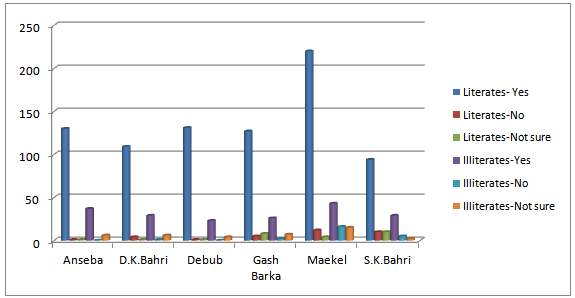 | Figure 15. Public Libraries towards National Development of Eritrea |
A majority 72.4% of literates and a small group of illiterates (16.7%) agree that the PL will help to improve National Development of Eritrea. Necessity of Right to InformationTable 16. Necessity of Right to Information
 |
| |
|
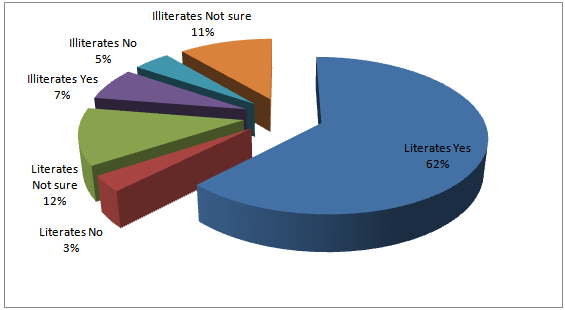 | Figure 16. Necessity of Right to Information |
A majority of literates feels the right to information is essential for life which will be fulfilled by the public library. Even among literates, more than 10% told no idea or not sure about the concept of right to information. This sample draws the attention of the government to take some necessary and urgent steps to create awareness among the public.
5. Major Findings
The final outcomes of the present research as obtained thorough survey reports are as under:• The first objective was to realise the statues of public libraries as a literacy centre in Eritrea. A survey was made between 1120 people, out of which 1032 people reacted. This makes the opinion of 92.14 percent people was in favour of public library. Which is the significant number to be acknowledged as a fact that to realize the status of public libraries as literacy centre in Eritrea. It was more interesting to note that out or 92.14 people making their opinion in favour of PL, about 51.96 % people were from rural areas, where illiteracy is more dominant in compression to urban areas. Such opinion brings some brighter picture of the fact that Public Libraries can serve as tool for removal of illiteracy as many of these villagers are devoid of teaching institutions.• The survey based study concluded that PL is a need of the hour as 75% of the respondents felt that they could spend their leisure time usefully if they have a PL in their home town. This was more needed as most of them have completed their literacy course. They were of the opinion that PL can make some positive changes in Eritrean life style. They also realized that PL is a very strong tool to remove adult illiteracy.• As has been stated earlier in the introductory part of my document about the concept of PL in some of the developing countries it is crystal clear by the percents of literate group that where ever PL existed the literacy was high. Because in free time there is a normal tendency and eager of human being to search for a literature, which is being translated by the literacy of these countries. Eritrea is an equal good example like these countries. People over here are also aware about the advantage of literacy and they have got an urge to learn. Poverty plays a major role as a hindrance in their path which could be very easily over come by the introduction of Public Libraries.• In the favor of the present objective a detailed Eritrean national literacy programme 2012-2016 has been suggested. The ministry of Education through the Department of Adult Education and Media has the mandate to lead and co-operate the implementation of Adult learning and education programmes in Eritrea. • Under this outcome a detailed survey report has been presented in various depicted tables in chapter four which clearly quantifies the measurement of the impact of adult literacy campaign in Eritrea and suggests prospective strategies to enhance its productivity/efficacy.• The importance of Public Libraries has already been acknowledged by both urban and rural societies of Eritrea. As urban society has so many access for CRR/PL. the only gap remain is rural society. As has been already pointed out that it is this weaker section of the society which gets more benefit by introduction of CRR/Pl as they do not have neither and access to school nor sufficient money for learning. Therefore for removal of illiteracy CRR/PL can serve as definite tool for these sections.
6. Conclusions
The importance of Public Library has already been acknowledged by both urban and rural societies of Eritrea. As urban society have so many accesses for Community Reading Room/Public Library, the only gap remain is rural society. As has been already pointed out that it is this weaker section of the society which gets more benefit by introduction of CRR/PL as they do not have neither and access to school nor sufficient money for learning. Therefore for removal of illiteracy CRR/PL can serve as definite tool for these sections. Eritrean people are aware about the advantage of literacy and they have got an urge to learn. Poverty plays a major role as a hindrance in their path which could be very easily overcome by the introduction of Public Libraries. The ministry of Education through the Department of Adult Education and Media has the mandate to lead and co-operate the implementation of Adult learning and education programmes in Eritrea. The study gives a small sketch for a systematic planning of the public library service in Eritrea. The study has provided some valid patterns to fight with adult illiteracy with the help of public libraries. The study tells about the provision of (community reading room) libraries for the small villages where immediately the public libraries cannot be created. The study also gives some tips to know the book donation programmes to meet the requirements for Public Library Service in Eritrea at the initial stages. The importance of Public Libraries has already been acknowledged by both urban and rural societies of Eritrea. As urban society have so many access for Community Reading Room/Public Library, the only gap remain is rural society.
7. Recommendations
The main focus of the study is to give adult education for the illiterates. In this study, the Microsoft excel mapping technique has been used which is the best suit for the unsupervised data. Using the technique, it has been proved that the eradication of illiteracy will give Human benefits, Political benefits, Democracy, Ethnic Equality, Cultural benefits, Social benefits, Health benefits, Education benefits and Economic benefits to the country. With these logical findings, we derive some useful recommendation to the Government of Eritrea which is as follows:The Government of Eritrea should take necessary steps to involve public libraries in the literacy movement. 1. The village libraries (community reading room) should run night schools and impart adult education and literacy. The librarian should be entrusted with the responsibility of creating reading habits among the village people.2. Separate budget should be allocated for library service under the Adult Education Programme Funds. In this regard, the government should give more funds for the development of public libraries.3. The primary and Mass Literacy Directorate, Non-Formal Education Directorate, Rural Development and Co-operatives Division and the Social Welfare Directorate may prepare their own action plan for using their own potentiality in the promotion of mass literacy.4. The Government of Eritrea has to give top priority to mass literacy. So, different activities and programmes for promoting literacy are being implemented through the government agencies and NGOs.5. Public library services should provide more extension services, like the radio and film vans, cultural programmes in local languages to attract different group of people like illiterates, neo-literates and the rural mass. Without these extension services, the neo-literates will soon relapse into illiteracy. Assessment findings of the adult literacy projects conducted in different Zobas in Eritrea showed significant accounts that can have great impact in future planning and management of the national literacy programme. To mention some:• Many illiterate adults who regularly participated in the literacy projects were able to read, write and keep written accounts of their own;• The new instructional materials prepared in local languages for adult literacy has gained wide acceptance and appreciation, followed by constructive comments and suggestions for further improvement;• There is common understanding among the concerned parties that it is much easier and effective to fight illiteracy co-operatively than to launch diverged literacy projects as was the case 5-6 years after independence.On the other hand, some critical problems and constraints were also noted during the implementation of the previous literacy projects. However, most of the constrains faced in the past can be avoided through proper planning, monitoring and follow-up. This can be possible only if the required literacy personnel are recruited and trained as well as supportive literacy committees established at different levels.In the final analysis, it seems it is reasonable to plan for an extended literacy programme in Eritrea, considering the following realities and possibilities:• The budget of the adult literacy had been increased in the past 3-4 years, and currently, adult literacy is funded jointly by the Government of Eritrea and SIDA Sweden, in continuation of the agreement reached to launch pilot literacy project started in 1998. it is anticipated this will continue at least for the coming five years Total budget required for the whole programme for five years is estimated at about 20 million USD.• Number of literacy centers increased by about eight times and enrolment almost doubled every year can at the worst time of the latest war with Ethiopia and its consequences. This shows that there is a high interest among the population to eliminate illiteracy. This will need proper planning and management at the national and zoba levels to provide an expended literacy programme.• The National Service Programme is one of the successful Government programmes, on which the national literacy programme can build. One activity to organize literacy training for the illiterate youth who joined the National Service and the second important activity is to direct enough number of youth from the national service to work in the literacy programme as part of their national obligation.Table 17. Number of illiterates to be literate in 5 years (age group 15-45)
 |
| |
|
In the coming five years it is assumed on less than 450,000 illiterates aged 15 and above will participate in the national literacy programme. It is anticipated that at least 85 percent of those who attend regularly will become literate. Majority of the target groups will be women, for the absolute number of illiterate population for more outnumbers the number of illiterate men. Efforts will be made to reach other disadvantaged groups. Special attention will also be given to the illiterate population in organized institutions such as workers and members of the National Defense Force.To carry out the different activities of the national literacy programme effectively, two steps should be followed:• Strengthen the existing adult education structure by recruiting and training adequate literacy personnel at all levels; and • Provide continuous support by creating literacy committees at different levels t fulfill certain essential duties.The establishment and functioning of the literacy committees will depend on the choice and situation of each zoba. But not only to create the structure, but also to establish effective working conditions will be essential.Monitoring and follow-ups as well as flow of information top-down and vice-versa will be done based on the established administrative and technical support structures. To find out the overall impact of the national literacy programme, tow major areas of evaluation will be undertaken: Evaluation of learning achievements and the programme setting (policies and strategies etc.)
References
| [1] | Ministry of Education. , 2011, “Annual report of Ministry of Education”, Asmara, Eritrea . |
| [2] | Margaret Baffour-Awuah., 2001, Village reading Rooms: Book Outreach in Botswana. School Libraries Worldwide, Gaborone, Volume 7, Number 2, 2001 , 65-71. |
| [3] | Aimut, T., 2001., Planning and management of the National Literacy Programme in Eritrea. Paris: UNESCO. |
| [4] | Md. Shiful Islam and Md. Hanifuddin., 2006, Malaysian journal of Library and Information Science, Vol 10, No.1, July 2006 : page 105-116 |
| [5] | Anup Kumar Das and Banwari Lal., 2006, Information Literacy and Public Libraries in India , published in the web site: http://openmed.nic.in/1278 of Bibliographic Informatics Division, National Informatics Centre, New Delhi on Jan 2006. |
| [6] | Pradeepa Wijetunge., 2000, The Role of Public Libraries in the Expansion of Literacy and lifelong Learning in Sri Lanka, New Library World, 2000, Vol.101, No-1155-2000, pp 104-111. |
| [7] | Campbell, Lyn., and Goldsworth, Carol.,1991, Victorian public libraries and adult literacy: a report of a project. South Melbourne, Vic., Victorian Ministry for the Arts, vii, 74 p., 4°. Annotated bibl.: pp. 53-74. |
| [8] | Adams, Sue; Krolak, Lisa; Kupidura, Eva; Pangerc Pahernik, Zvonka: Libraries and Resource Centers: Celebrating Adult Learners every week of the year.,In: Convergence. Vol. XXV, Nr. 2-3, 2002. pp. 27-38. |
| [9] | Rosenberg, Diana, ed., ADEA., 2000, Working Group on Books and Learning Materials (UK). Books for schools: improving access to supplementary reading materials in Africa. Oxford, African Books Collective, 2000. xii, 200 p. |
| [10] | Mahapatra, P.K and Thomas, V.K, ed.,1996, Public Libraries in Developing Countries: Status and Trends (Dr. B.P. Barua Festschrift Volume), New Delhi: Vikas Publishing House,. pg. xiii-xiv. |
| [11] | http://rti.gov.in |






 Opinion of the illiterates has revealed the following pattern. About 64.71 percent people were of the opinion that so as to gain knowledge and wisdom education plays a important role, however 64.59 percent of the respondents amongst illiterates considered that education causes awareness towards society and world. About 74.37 percent respondents felt to go for learning in another area where public library can play a major role.Hobbies of Illiterates
Opinion of the illiterates has revealed the following pattern. About 64.71 percent people were of the opinion that so as to gain knowledge and wisdom education plays a important role, however 64.59 percent of the respondents amongst illiterates considered that education causes awareness towards society and world. About 74.37 percent respondents felt to go for learning in another area where public library can play a major role.Hobbies of Illiterates
 Out of 238 respondents in 24 hours makes 5712 man hours. Out of this 5712 hours time about 397.2 hours were just spent in chatting which makes it very clear that about 6.95 percent of their time was wasted in chatting. Similarly 6.82 percent of their time was spent in viewing television, 4.07 percent was spent for gambling. Hence it is clear that illiterates waste their time in evil affairs rather than construction matters.Utilizing mass media by residenceThe information needs of rural may be better served by radio and television broadcasting, among other means, but in order to assess the possibilities and establish clearly defined roles in information provision for library services on the one hand and broadcasting services on the other, it is necessary to obtain a clear picture of the existing situation in the field of broadcasting in Eritrea .The following table illustrates the utilization of the different media system both in rural and urban sector.
Out of 238 respondents in 24 hours makes 5712 man hours. Out of this 5712 hours time about 397.2 hours were just spent in chatting which makes it very clear that about 6.95 percent of their time was wasted in chatting. Similarly 6.82 percent of their time was spent in viewing television, 4.07 percent was spent for gambling. Hence it is clear that illiterates waste their time in evil affairs rather than construction matters.Utilizing mass media by residenceThe information needs of rural may be better served by radio and television broadcasting, among other means, but in order to assess the possibilities and establish clearly defined roles in information provision for library services on the one hand and broadcasting services on the other, it is necessary to obtain a clear picture of the existing situation in the field of broadcasting in Eritrea .The following table illustrates the utilization of the different media system both in rural and urban sector. 




 75% of respondents feel that they can spend their leisure time usefully if they have a library in their places after completion literacy course. This implies that the public library definitely will create some positive changes in Eritrean life style. And also a majority of people i.e. 77.68% feels they will acquire knowledge or adult education. More than 38.57 % Eritrean want reading materials which is related with their professional skills in libraries.Ranking of Reading materialsRanking Resources for a new establishing public library system.The following tables 12, 13 illustrate the ranking of reading materials and subjects in the proposed new public library.
75% of respondents feel that they can spend their leisure time usefully if they have a library in their places after completion literacy course. This implies that the public library definitely will create some positive changes in Eritrean life style. And also a majority of people i.e. 77.68% feels they will acquire knowledge or adult education. More than 38.57 % Eritrean want reading materials which is related with their professional skills in libraries.Ranking of Reading materialsRanking Resources for a new establishing public library system.The following tables 12, 13 illustrate the ranking of reading materials and subjects in the proposed new public library.


 From the existing system to a new system of library, the users were asked the service preferred. The following depicts the opinion of the users in this regard.Most of the respondents prefer circulation of books, periodicals and other reference materials. The essential factor to note down that more than 65% of the respondents have stressed the need of public library services to attract the children, women, old aged people and the library service to educate the illiterates. National development and Right to information about Public LibraryNational developments in terms of happiness of Eritrean people, rather than in terms of an abstract economic measurement of Gross National Product. The principle describes the development as a continuous process towards a balance between material and non-material needs of individuals and society. National Development has become the philosophical foundation for the policy making process and implementation in Eritrea.Freedom of information legislation described as open records or sunshine laws are laws which set rules on access to information or records held by government bodies. In general, such laws define a legal process by which government information is required to be available to the public. In many countries there are constitutional guarantees for the right of access to information, but usually these are unused if specific legislation to support them does not exist. Over 70 countries around the world have implemented some form of such legislation. In India, the Right to Information Act (RTI Act) was introduced to the Indian Parliament in July 2000. It came into effect on 12 Oct 2005. Other countries are working towards introducing such laws. http://rti.gov.in[11]The tables 15 and 16 depict the opinion of respondents of the survey on the GDP and the right to information respectively.Public Libraries towards National Development of Eritrea
From the existing system to a new system of library, the users were asked the service preferred. The following depicts the opinion of the users in this regard.Most of the respondents prefer circulation of books, periodicals and other reference materials. The essential factor to note down that more than 65% of the respondents have stressed the need of public library services to attract the children, women, old aged people and the library service to educate the illiterates. National development and Right to information about Public LibraryNational developments in terms of happiness of Eritrean people, rather than in terms of an abstract economic measurement of Gross National Product. The principle describes the development as a continuous process towards a balance between material and non-material needs of individuals and society. National Development has become the philosophical foundation for the policy making process and implementation in Eritrea.Freedom of information legislation described as open records or sunshine laws are laws which set rules on access to information or records held by government bodies. In general, such laws define a legal process by which government information is required to be available to the public. In many countries there are constitutional guarantees for the right of access to information, but usually these are unused if specific legislation to support them does not exist. Over 70 countries around the world have implemented some form of such legislation. In India, the Right to Information Act (RTI Act) was introduced to the Indian Parliament in July 2000. It came into effect on 12 Oct 2005. Other countries are working towards introducing such laws. http://rti.gov.in[11]The tables 15 and 16 depict the opinion of respondents of the survey on the GDP and the right to information respectively.Public Libraries towards National Development of Eritrea

 Abstract
Abstract Reference
Reference Full-Text PDF
Full-Text PDF Full-text HTML
Full-text HTML















